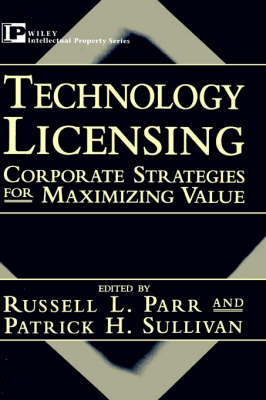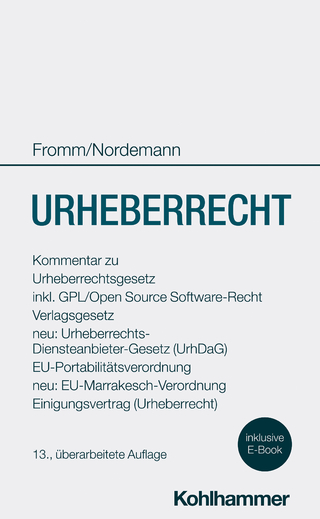
Technology Licensing
John Wiley & Sons Inc (Verlag)
978-0-471-13081-9 (ISBN)
Find out how today's top technology-based companies get thegreatest return on their intellectual property, and how you cantoo.
A total hands-on guide to cutting-edge technology licensingstrategies
Russell Parr and Patrick Sullivan, along with a team ofdistinguished experts working at the frontlines of technologylicensing, reveal how today's top technology-based companies aremaximizing the value of and return on their intellectual property.They also offer hands-on advice and guidance on how you can do thesame in your company. With the help of numerous real-life casestudies that demonstrate licensing strategies now used at DuPont,Xerox, Kodak, AlliedSignal, Hewlett-Packard, Dow Chemical, andother industry leaders, they tell you everything you need to knowto:
* Determine where technology licensing best fits in your company'soverall business strategies
* Establish a successful licensing program tailored to yourcompany's vision and goals
* Create and successfully manage a technology portfolio
* Quickly and easily calculate royalty rates
* Put the lessons learned at top technology-based companies to workin your company
"Technology licensing strategies are now key instruments foraccomplishing the corporate visions set forth by future-thinkingcompanies. Look at any corporate mission statement and you willfind the seeds of a strategy-based technology licensing program."--Russell Parr and Patrick Sullivan
In today's volatile, hypercompetitive global marketplace,cooperation and the sharing of intellectual property are keys tosuccess. Of course, one of the most valuable forms of intellectualproperty is technology. More often than not, innovation andincreased market penetration are the direct result of combiningtechnologies from a variety of sources. Consequently, manycompanies have begun to devote more and more of their strategicefforts to discovering the best ways to manage technology so as tomaximize value and return. For instance, AT&T has set up anindependent business group to manage its intellectual property as aseparate profit center, while other companies continue to runlicensing through their legal and R&D departments. Whichapproach makes the most sense for your company, and why? Get theanswers to these questions and many others in TechnologyLicensing.
In this valuable book, Russell Parr and Patrick Sullivan, alongwith a distinguished team of contributing experts, reveal thelicensing strategies now being used at DuPont, Xerox,Hewlett-Packard, Dow Chemical, Kodak, and other top multinationalcorporations. They also provide practical prescriptions fordetermining where technology licensing belongs on yourorganizational chart and for establishing a successful licensingprogram tailored to your company's vision and goals.
Taking a practical hands-on approach to technology licensing, theytell you what you need to know about:
* Creating and managing technology portfolios
* Types of licenses--with a detailed analysis of the strengths andweaknesses of each in various business contexts
* Successful licensing strategies now used at top technology-basedcompanies
* Royalty rate determination methods
* And more
Drawing upon the expertise of those on the frontlines of technologylicensing, Technology Licensing tells you how today's toptechnology-based firms maximize the value of their intellectualproperty and how your company can too.
About the editors RUSSELL L. PARR, CFA, ASA, is a Senior Vice President of AUSConsultants, where he assesses the value of intellectual propertyand advises his clients about the investment value of patents,trademarks, and copyrights. A sampling of his clients includesAT&T, Battelle, Pfizer, Silicon Graphics, TRW, and Exide Corp.He is the author of Intellectual Property: Licensing and JointVenture Profit Strategies and three other books, and publisher ofLicensing Economics Review. Mr. Parr holds an MBA and a BS inelectrical engineering and is working toward a PhD in internationalbusiness strategies. PATRICK H. SULLIVAN, PhD, is a founding partner in the ICM Group, aconsulting company focused on extracting value from intellectualcapital. He also develops business, financial, and technologystrategies for technology-based enterprises and values intellectualassets for business and management use. A sampling of his clientsincludes Dow Chemical, Xerox, NASA, General Motors, the Universityof Chicago, and Stanford University. He is also affiliated with Law& Economics Consulting Group, an expert testimony firm. Dr.Sullivan has an undergraduate degree in engineering, a master's inR&D management, and a doctorate in business administration.
Partial table of contents:
LICENSING STRATEGY.
Vital Resource of the Future--Knowledge (R. Parr & P.Sullivan).
Key Terms and Strategic Positions (P. Sullivan).
Intellectual Property Portfolios in Business Strategy (P.Sullivan & J. Daniele).
Strategic Objectives Supported by Licensing (J. Nickerson).
Central Control of Technology Licensing (R. Parr).
Gaps Analysis (R. Parr).
ROYALTY RATES.
The Importance of Context in the Derivation of Royalty Rates (S.Sullivan).
Advanced Royalty Rate Determination Methods (R. Parr).
INTELLECTUAL CAPITAL.
A Model for Managing Intellectual Capital (P. Sullivan & L.Edvinsson).
The Future of Intellectual Capital Management (R. Parr & P.Sullivan).
Appendix.
Index.
| Erscheint lt. Verlag | 4.9.1996 |
|---|---|
| Verlagsort | New York |
| Sprache | englisch |
| Maße | 162 x 242 mm |
| Gewicht | 670 g |
| Themenwelt | Recht / Steuern ► EU / Internationales Recht |
| Recht / Steuern ► Wirtschaftsrecht ► Urheberrecht | |
| Technik | |
| ISBN-10 | 0-471-13081-8 / 0471130818 |
| ISBN-13 | 978-0-471-13081-9 / 9780471130819 |
| Zustand | Neuware |
| Haben Sie eine Frage zum Produkt? |
aus dem Bereich


